Penultimate day for the excavation.
Of the 4 + 1 trenches we initially opened, all but one have been subject to investigation.
Trench 1 is in the final stages of recording, We have the titula/titulus/titulum pick your poison, sectioned, as well as the east terminal of the main ditch at the north entrance to the marching camp. A conundrum that has been bothering us all since the early clean up phase of Trench 1 is a linear feature some 1.5 m wide that runs across the full extent of the trench and is parallel with the camp entrance, but between the entrance and the titula, there is some evidence from the magnetometer survey of a linear feature that straddles the front of the camp entrance behind the titula. When trying to understand the geology on the site Brian Dale the landowner advises that generally across the farm there is a 50mm lens of hard compacted sand and gravel below the top soil, above looser predominately sand and gravel subsoil, this was the evidence we were presented with on opening up the site across all of the trenches. The surface of the linear feature conformed to what we initially believed to be natural geology. The evidence is however starting to mount up that whilst this hard lens may well be of the same material and texture as that which generally overlies the sand and gravels where there is no archaeology , it is is becoming apparent that it is also appears to be reforming over archaeological deposits over a given timescale through settlement of material from the deep topsoil.
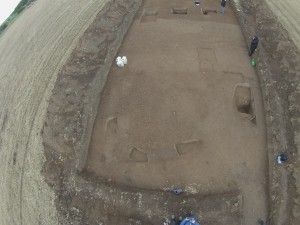
Trench 2 is also approaching completion, the section across the ditch that forms the subdivision of the marching camp has been fully sectioned and conforms to standard roman ‘V’ shape with ankle breaker, although to a lesser scale than the marching camp ditch. Removal of some of the burnt sculptured sand has revealed what appears to be an extensive area of what appears to be carbon deposits, although including the ubiquitous rotting and delaminating black shale found extensively in every trench.
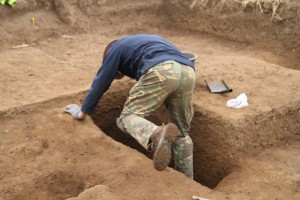
Trench 3
This trench although opened up and cleaned has not been excavated, Due to an error on my part in transposing the trenches from an ungridded survey to a gridded survey to aid measuring the trenches in, I accidentally located the trench a few metres to the west of the original plan.
Although the trench still captured the road ditch? that ran East/west across the site, it missed a circular feature we were interested in. However by accident we have potentially located far more important evidence of later settlement activity on the site, with two sides of a rectangular timber framed? building with an internal division. Of even more interest the building cuts through an earlier curved feature, and is itself cut through by the road ditch that was the original purpose of opening up the trench. Perhaps I should claim divine intervention for my mistake. Anyway a prime candidate for work next year.
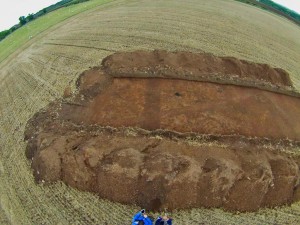
Trench 4
Excavating still in full flow, ditch we thought was some sort of foundation ditch for a rectangular building from the mag has turned out to be way too big for a foundation trench. At 20m long by 10m wide, we must now expect to potentially have a structure inside it. Possible candidate for next year.
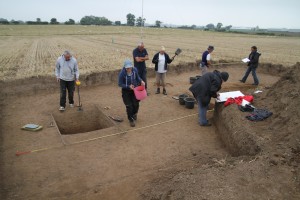
Trench 5
This was the trench excavated some 30m east of the main gate with the aim of identifying a clean section of the main marching camp ditch away from the main gate. unfortunately it was just as hard to locate and identify the feature here. Eventual technique required to identify the ditch was to remove 25m of the hard sand and gravel lens across the whole trench, and keep doing it until the feature appeared. It required the removal of 75mm of material before at last we could seperate the natural from the archaeology. The ditch was fully excavated with no finds, it is 2.4m wide and 2.1m deep from the current ground surface to the bottom of the ankle breaker, and 1.4m from the bottom of the topsoil. On the inside of the ditch there is a textual change suggestive of the remains of the bank which unfortunately extends outside the limits of our trench. A further feature found on the final clean down before photography was a ditch running across the bank at an angle with a burnt edge on one side.
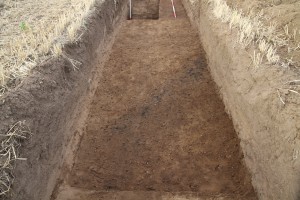
Last day tomorrow!!!
